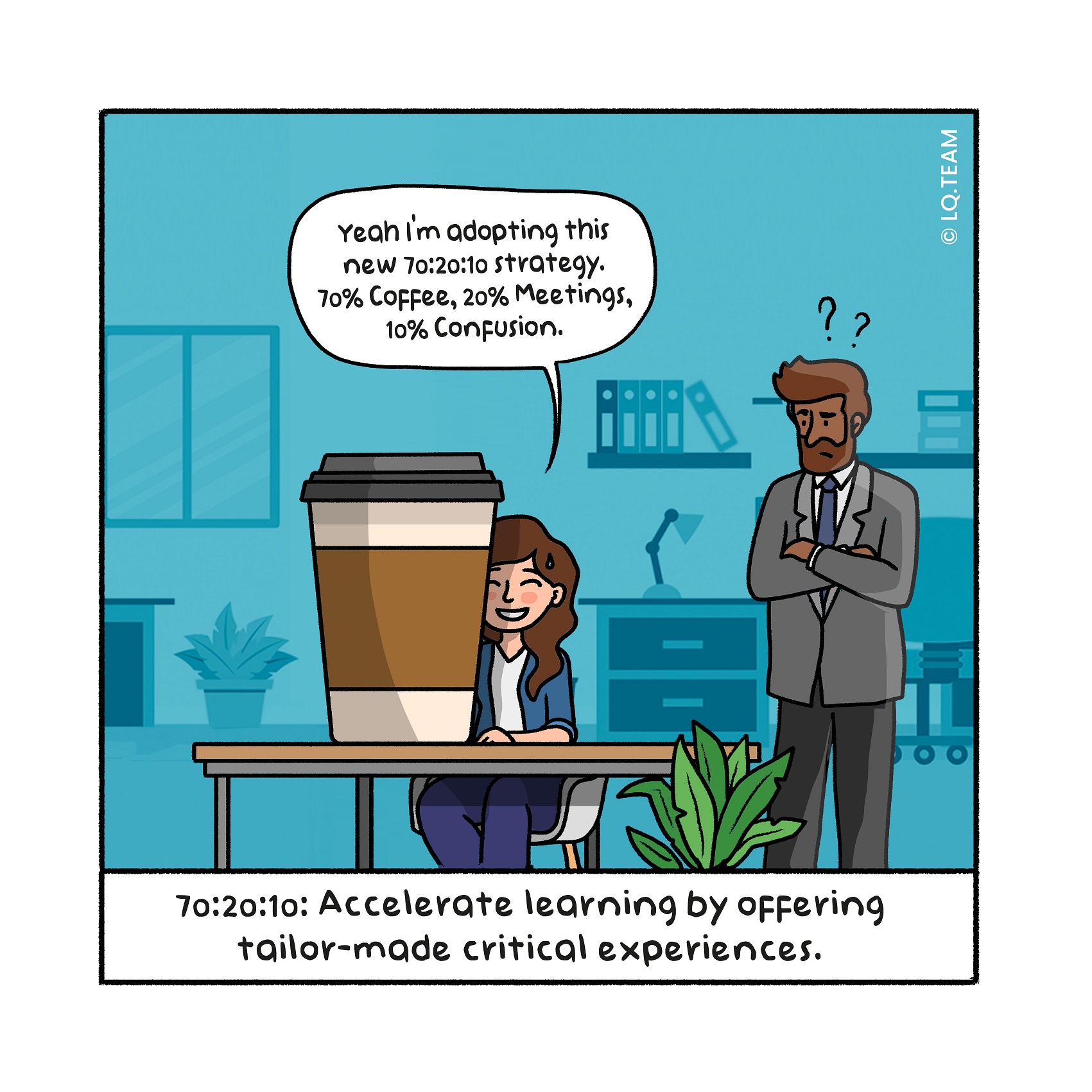
Nut to crack: How do you accelerate the learning curve of individuals?
Suppose you have cracked Challenge 40, and you have a good understand- ing of the match between the talent of individuals and the needs of the organ- isation and, therefore, also know where there are still gaps. How do you fill those gaps as quickly as possible? Do you look externally? Or do you invest in the growth of your people? And if you opt for the latter, how do you accelerate the learning curve of individuals?
Nutcracker: Offer tailor-made critical experiences
Charles Jennings is the founder of the 70:20:10 principle16: 70% learning through work, 20% learning through coaching and feedback, and 10% learn- ing through formal training. If you apply that principle, real learning takes place in practice. That is also where you can accelerate growth.
You can achieve acceleration by offering critical experience; necessary crit- ical experience accelerates the preparation of individuals for a future role. For example, imagine you would like to prepare a 35-year-old manager for a business unit role with profit & loss accountability in three years. The critical experience required to perform that role is to have:
- led a team hierarchically
- developed a business strategy
- led an organisational change, for example, a reorganisation
- drawn up and managed a budget of > 1 million euros
- overseen at least two functional disciplines, such as sales and operations, and
- built a network relevant to the industry
Suppose this manager:
- lacks experience in developing a business strategy
- has directed only one functional discipline
- has limited people management experience
Then the trick is to find a process that brings those three experiences to- gether.
In this case, this manager was made responsible for reorganising a small loss-making business unit. By getting him to supervise the turnaround for two years, he gained relevant critical experience in a short time, which prepared him for the following role relatively quickly.
A precondition for this acceleration is that the individual’s ability to grow is sufficiently present, just like the cultural fit. Therefore, these hygiene factors need to be available for the investment in growth to pay off.
Real-life example: Accelerate succession in a family business
In a thirdgeneration family business, its patriarch Maurits, currently at the helm, wants to hand over the organisation to his daughter Isabelle in five years. Isabelle is currently responsible for the ecommerce domain. This is the third job in her career – a career she started in the family business.
Just like her father, Isabelle has the ambition to lead the company, except that she has just had her first child and wants to have a larger family in the coming years.
As the company owner and Isabelle’s father, Maurits is at a loss about what to do. He wants to continue working for a few more years, but this doesn’t seem sufficient time to be able to transfer the company to his daughter. What should he do?
Maurits talks to several fellow directorowners about how they tackled succession issues in their organisations. He learns that they have set up family offices to guide the careers of family members in a targeted manner, with mappedout paths of critical experiences and precise demands and expectations from both sides.
Given the scale of his organisation, with a few thousand employees and one family mem ber eligible for succession, Maurits sees no reason to set up such a formal structure. It did trigger a wakeup call, however, because the degree of professionalism and solidity of such processes by the others made him aware of the lack of planning and weakness in guidance in his organisation.
He therefore hires a knowledgeable professional and explores the actual demands of the role of ceo in his family business, as well as the path of critical experience it takes to get there. This gives him the knowledge that, even if Isabelle were to focus entirely on her career, she would still need at least eight to ten years to be fully prepared for the role. Father and daughter have a good conversation. Together they conclude that Isabelle would like to follow this path and accept the challenge of realising the role requirements but also she wants enough time to do this properly.
So they decide that, in the meantime, a seasoned external manager who is already working in the company will be readied to lead the business in three years’ time so that Isabelle does not have to take over the organisation’s management until she is ready.
Tip for change leader
Say goodbye swiftly to employees who don’t fit with your organisation’s culture, or if you have assessed their ability to grow to be insufficient, so neither party wastes energy unnecessarily.
Tip for change enabler
Inspire the organisation with examples of what a growth path to key roles in the organ isation can look like. Do this by sharing the interviews with people in the organisation who have performed well and shown rapid growth. Question them about what they did, thought and said during key deciding moments in their careers. Then you will uncover the real unpolished stories, which can give others that little nudge they need to get moving.
Kernel: Accelerate growth through targeted design
Custom-design critical experiences to accelerate the growth of individuals or groups of individuals. Do take advantage of opportunities that present them- selves now, so you design experiences that simultaneously generate growth for the individual, the customer and the organisation.
